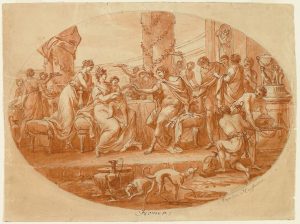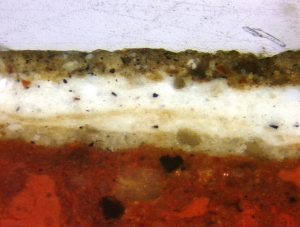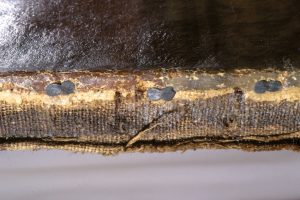Catalogue Raisonné
The core of the AKRP – Angelika Kauffmann Research Project is the Kritische Werkverzeichnis Angelika Kauffmann / Catalogue Raisonné Angelica Kauffman presently in preparation. In this multi-volume publication, which is being edited by Bettina Baumgärtel, the complete works of the artist will be catalogued, systematically investigated, and discussed.
The aim is to classify according to a categorical system all of the paintings, drawings and etchings (in all states) – as well as the graphic reproductions after Kauffman’s works as comprehensively as possible, to research them art historically, and to document them in a scholarly catalogue, all for the first time.
In conjunction with the catalogue raisonné, a database is being compiled in collaboration with Gabriele Ewenz. This data base comprises:
- a source corpus – an annotated documentation of source texts, some as yet unpublished
- a largely complete bibliography (presently 2,500 entries)
- an index of places and persons
- an index of the locations and titles of the works, etc.
Already during her lifetime, the artist’s works were briskly traded and enthusiastically collected, above all – in keeping with her international clientele –in England, Scotland, and Ireland, in Austria and Switzerland, in Poland, Italy, France, Scandinavia, the Baltic countries and Russia, as well as in the U.S. and Australia. On account of the great demand, Kauffman herself executed replicas of a number of her paintings. Copyists and forgers also took advantage of the situation.
In the case of Angelika Kauffman, the number of deattributions, including the copies and imitations, has already long exceeded the number of proven Kauffman originals by more than half.
As long as the oeuvre is burdened by such a mass of erroneous attributions, the perception of that oeuvre will remain distorted. Under these circumstances, Kauffman’s artistic achievement cannot be fairly evaluated, and it is equally unjust towards the actual authors of the works in question to withhold the credit due them (Ill. 49, PDF-File).
The work on the critical catalogue raisonné – as is suggested by the adjective – is to take the inquiry into the individual work as its point of departure, and accompany that inquiry with critical reflection. The questions to be asked are how we define a work, when it can be considered an authorized work by the artist, and how great a share of the work has to have been executed by the master’s hand in order to be considered an original.
A work is naturally more than its pure materiality. It also encompasses its intellectual potential and its history, closely linked with the history of the client and owner. Within the cultural context, it has a specific – sometimes also a changing – function as a collector’s item or commodity. It develops a specific effect within the framework of exhibitions and can be part of a (museum) presentation; in other words, it looks back on a history of its own reception and impact. Material changes to which it has been subjected (e.g. overpainting, cropping, framing) can also serve as indications of changing tastes. The critical catalogue raisonné provides a fund of facts as a basis for the investigation of all these many questions.
In view of these deliberations, the AKRP has consistently expanded and refined its criteria for the critical cataloguing of a work. Taking standardized measures as a starting point, it has developed a well-differentiated critical approach to attribution permitting a more well-founded answer to the question authentic or not authentic.
Whereas the protagonists of the fast-paced business of art dealership often merely distinguish between whether a work has been painted by the artist’s own hand or not, here it is necessary to formulate the question as to a work’s authenticity in terms of subtle gradations, and to evaluate the work accordingly. We accordingly distinguish between: original, replica, workshop copy, ricordo, original reworked by a hand other than the artist’s, joint work, copy by a hand other than the artist’s, circle of, follower of, manner of and forgery.
Scholarly integrity demands that attention be called to the fact that there are cases of doubt which cannot be clarified on the basis of the present state of the research.
Above and beyond the question of authenticity, the AKRP has gained many new insights into the artist’s workshop situation and her clients. Intensive archive and provenance research on the individual works provides an additional means of underpinning attributions and deattributions.
As already mentioned, there are a great number of supposed but not authentic Kauffman works in circulation. This circumstance makes it difficult to gain a clear view of the oeuvre as a whole, and helps to emphasize the urgent necessity of turning to scientific analysis as a further clarification aid. It moreover confirms that view that the clarification of the oeuvre is only possible within the framework of a research endeavour that is independent of market interests as well as the pressure of the fast-paced event business.
The AKRP draws on the latest technological investigations methods as an aid in its critical appraisal of the Kauffman oeuvre. At the same time, it should be pointed out that these methods do not replace appraisal on the basis of art-historical knowledge and connoisseurship or the hermeneutic approach as an interpretive method.
The catalogue raissonné differs fundamentally from a list of works by virtue of its scholarly-critical approach. Work lists of the kind frequently found on the Internet these days often represent little more than the diligent, uncritical compilation of objects. In contrast, we have decided on the following approach: we single out each of the working steps in the process of drawing up a catalogue and subject it to critical questioning and examination with regard to our research methods and materials, our criteria for selection, description and classification, our terminology and the structure of the cataloguing process, and the overall catalogue concept.
The verification of facts is a major effort in its own right, but depending on the respective state of research, the examination of facts requires various degrees of depth. Here the AKRP is dependent on the help of many prudent thinkers.
An important criterion for a catalogue raisonné is completeness. In this context, one widespread approach is to include only the verified works, while listing only a few doubtful works in an appendix. Our conception of completeness is broader. In addition to the verified and questionable works, the deattributed works are also to be mentioned to the extent possible, along with insights into the criteria of the attribution and deattribution. This we regard as the only means of rooting out the firmly entrenched circulation of erroneous attributions.
The first step is to document all original, unverified, and erroneously attributed cases, complete with all technical details such as painting surface, painting materials, support systems, frames, etc., in conjunction with databases on provenance, primary and secondary literature, and indexes of persons and places.
To this end, a large number of research trips have been undertaken in Europe (including Russia) and the U.S. since 1982. Such travels guarantee the first-hand study of the original works and sources. To this day, works believed irretrievably lost continue to turn up, for which reason the collection and documentation efforts are still in progress.
In addition to their art-theoretical appraisal, the originals also undergo scientific-technological examination in cooperation with Inken M. Holubec, followed by intensive follow-up evaluations and art-theoretical analysis.
The AKRP has meanwhile carried out a great number of systematic investigations of originals at the research facility in Düsseldorf as well as at other facilities in Germany and abroad. In this context, the project has received kind support from many colleagues in the public museums and collections.
Within this context, incident light and grazing light, enlargements, and radiation methods such as ultraviolet fluorescence, infrared and x-ray are employed. Macro photographs provide visual access to the finer structures of the work and the artist’s specific style.
In a number of cases, tiny samples of the painted surface are taken and microanalytically examined. Cross-section samples are taken by a specialized laboratory. On the basis of cross-sections, the composition of the pigments and binding agents can be ascertained with the aid of incident light and ultraviolet microscopy, scanning electron miscroscopy, energy-dispersive x-ray spectroscopy (EDS) and Fourier-transformed infrared spectroscopy (FTIR) (Ill. 50, PDF-File).
The chief emphases of these investigations are on the determination and reconstruction of the painting surface in all its layers, from the choice of material used for the underlying surface to the preparation of the painting ground to the pigment and colourant palette, all within the context of the place of execution and the phase within the artist’s oeuvre.
The technological information permits conclusions to be drawn about supply sources and trade channels in the eighteenth century, as well as about the artist’s individual working and painting manner in the various phases of her career. It serves as an aid in distinguishing between different “hands” in cases of paintings from the workshop circle, collaborations with other artists, and contemporary or later replicas and copies. What is more, the objects’ state of preservation as well as later changes and damage are documented.
The AKRP records these scientific and technological findings on the individual works in a database. In the long term, the precise investigations of the objects will help to compile statistical data concerning Angelica Kauffman’s employment of canvas and other materials for the underlying surfaces, primers, binding agents, pigments, varnish, support systems and decorative frames. The technological data and information are regularly expanded to include the findings obtained through the scientific examination of pigment samples and painting layer compositions carried out in the microanalytical laboratory of Prof. Dr. Elisabeth Jägers and Dr. Erhard Jägers. (Ill. 51).
The results are placed into the context of historical sources on painting techniques and works by contemporary artists as well as the current state of the research carried out internationally on the painting techniques of the eighteenth century. The AKRP hopes by these means to make a contribution to the study of historical painting media and painting techniques of Neoclassicism.
This aspect of the AKRP’s work should be qualified, however, by the observation that these scientific and technological analyses can help to objectify attribution issues and base the related discussions on facts, but they are no substitute for art-historical or aesthetic appraisal.




